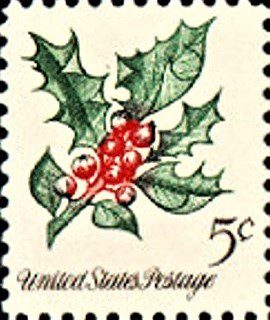In this festive holiday season we remember Katherine Hyde, artCentral’s benefactress. Herself an aspiring artist, she bequeathed her family home and the surrounding grounds always to be used in service to art and artists.
Built in the 1890’s as a foursquare American farmhouse, beautiful Hyde House is surrounded by old growth maples, sweet gum and oak trees as well as the ornamentals Ms. Hyde added. She especially loved holly trees. Four majestic ones continue to grow and tower: two in the thicket beside Thirteenth Street, one by the back patio and another in front of the old carriage house.
Boasting a long history of cultural significance, with deep green, thick, leathery leaves having serrated edges and spiky points, holly is a loved addition to our holiday decorations. Native to western and southern Europe, northwest Africa, and southwest Asia, female hollies produce the scarlet berries. Though toxic to humans and pets, they are a nutritious food source for winter birds like robins and cedar wax wings that winter nest in hollies for warmth and protection in the shelter of their evergreen leaves.
Prior to Victorian times the term “Christmas tree” actually referred to the holly tree which was considered the evergreen twin of the oak. The holly is one of the most cherished and revered trees in the mythology of my Celtic people. While the oak is understood to be the controller of the light half of the year, the holly tree is believed to control the dark, winter months.
In Celtic mythology, the holly symbolizes peace and goodwill. Due to its resistance to lightning, it is associated with the Celtic and Norse gods of thunder, Taranis and Thor, and so was planted near dwellings to protect people from lightning strikes.
The Druids regarded magically powerful holly, like mistletoe, to be sacred—a symbol of fertility and eternal life. Newborn babies were bathed in water from holly leaves to protect them from harm. For centuries the magic of the holly was called upon by Celtic chieftains who wore crowns of holly for good luck.
Holly was adopted by Christians as a symbol of Christmas—the sharp leaves representing the crown of thorns worn by Christ, while the berries represent his blood. The holly’s evergreen nature is considered a metaphor for enduring, eternal life.
Since medieval times holly’s Christian symbolism, has been expressed in the popular Christmas carol “The Holly and the Ivy”, in which the holly represents Jesus and the ivy represents His mother, the Virgin Mary. A Christian legend states that holly berries were originally white, but that the blood Christ shed for the sins of humankind stained the berries forever red.
Decorating with holly today brings many centuries’ old traditions into our modern festivities. Using holly to deck the halls with boughs or in swags or over doors or in wreaths or arrangements or mixed bouquets brightens any décor with radiance and meaning. At artCentral the brilliant berries remind us to give thanks for Katherine Hyde and her generosity.




















